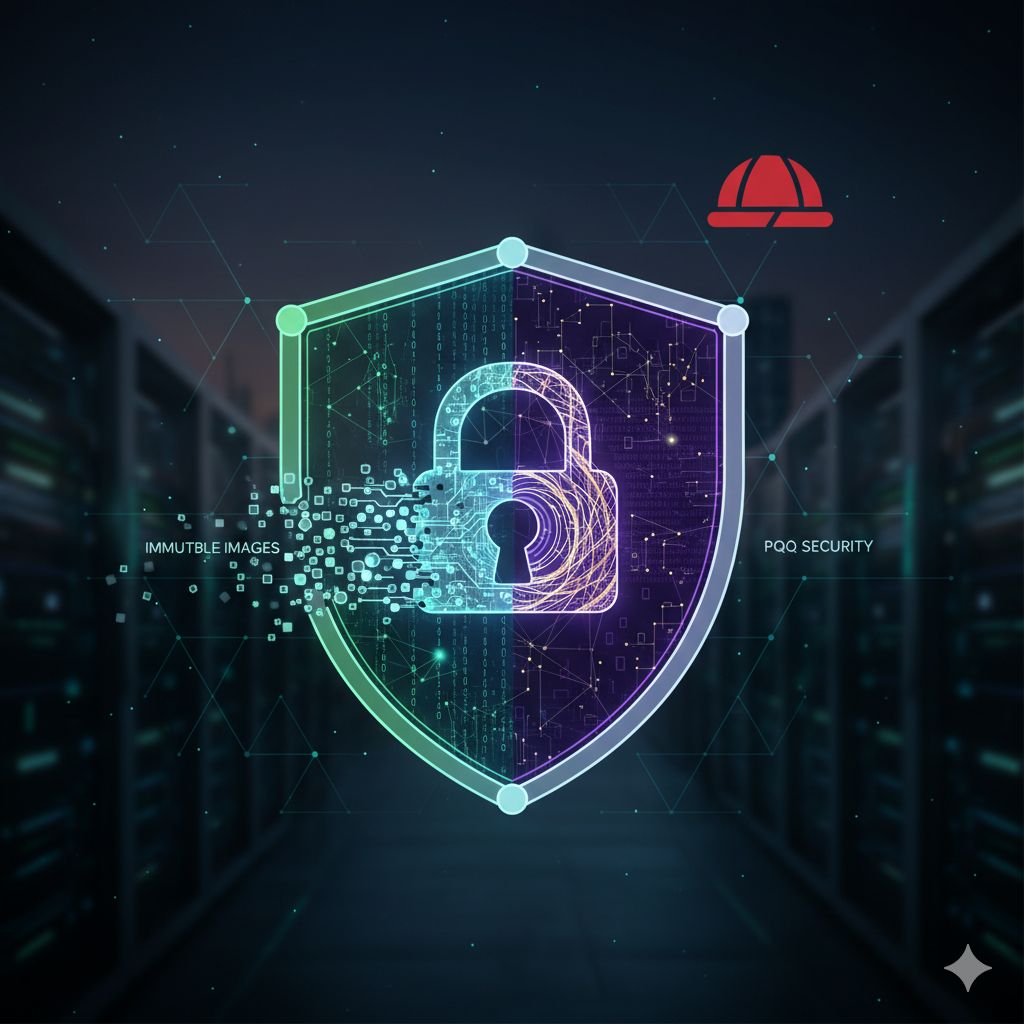
RHEL Edge: Immutable Images and PQC Security
Edge computing is now the most critical frontier of enterprise IT infrastructure, where Red Hat Enterprise Linux faces challenges that transcend traditional data center paradigms. When we talk about managing five thousand industrial gateways distributed across manufacturing plants, ten thousand 5G base stations along highway corridors, or one hundred thousand connected automotive devices, the classic system administration model collapses under the weight of operational complexity. RHEL's image mode, built on the OSTree architecture, emerges as the architectural response to this scenario, while post-quantum cryptography is a non-negotiable requirement for protecting assets that will remain operational for decades.
The Paradigmatic Transformation of Immutable Images
The concept of an immutable operating system radically redefines the approach to managing Linux distributions at the Edge. Where traditionally each device represented a mutable entity, subject to configuration drifts through years of incremental patches and manual changes, RHEL introduces a declarative model in which the state of the system is defined atomically through versioned images.
This architecture eliminates the problem of snowflake servers, that insidious condition where each node becomes unique and unreplicable, turning disaster recovery into an archaeological task. OSTree operates as a git-like versioning system for entire filesystem hierarchies, enabling instant rollbacks and atomic deployments that guarantee the all-or-nothing property essential for mission-critical environments.
When an update fails on a remote wind turbine or industrial controller, the system automatically restores the previous image without human intervention, maintaining operational continuity even in the presence of intermittent connectivity measured in kilobits per second.
Event-Driven Orchestration for Distributed Fleets
Managing thousands of edge endpoints requires an automation infrastructure that transcends periodic polling, embracing instead reactive, event-based paradigms. Event-Driven Ansible represents the necessary evolution for this context, where administrative actions are triggered by specific conditions detected through continuous telemetry rather than rigid time scheduling. Imagine a scenario where a temperature sensor on an industrial gateway exceeds predefined thresholds: the system can automatically activate playbooks that diagnose the thermal status, reduce the computational load, and notify operational teams, all without any manual intervention.
The integration between Red Hat Ansible Automation Platform and RHEL for Edge allows you to define declarative policies that govern thousands of devices simultaneously. The ability to react to events from webhooks, MQTT messages, or Apache Kafka streams transforms automation from a batch process to a distributed nervous system, where every anomaly, every configuration drift, every intrusion attempt automatically generates orchestrated and proportionate responses.
Post-Quantum Security as an Architectural Imperative
The quantum threat is not futuristic speculation but a strategic reality that impacts today's architectural decisions. Edge devices installed today in automotive, critical infrastructure, or telecommunications will remain operational until 2040 and beyond, at which point sufficiently powerful quantum computers could compromise current cryptographic algorithms based on RSA and Elliptic Curve. RHEL addresses this challenge by integrating NIST-standardized post-quantum cryptographic algorithms, specifically CRYSTALS-Kyber for key encapsulation and CRYSTALS-Dilithium for digital signatures.
Practical implementation requires hybrid transitions where classical and post-quantum algorithms operate in tandem, ensuring compatibility with the existing ecosystem while building quantum resilience. Communications between edge devices and the control plane must adopt hybrid key exchange, combining ECDHE with Kyber to ensure security against both classical and quantum adversaries. This two-tier architecture introduces measurable computational and bandwidth overhead, requiring careful profiling for resource-constrained devices, but represents the only sustainable defensive strategy for infrastructures with a decade-long lifecycle.
Lifecycle Management in Disconnected Environments
Industrial edge environments frequently operate under intermittent connectivity or completely air-gapped conditions, where direct access to Red Hat repositories is technically impossible. RHEL Image Builder becomes an essential tool for building customized images that incorporate all necessary packages, domain-specific configurations, and corporate security policies into self-sufficient artifacts that can be distributed through alternative channels such as removable storage, isolated local networks, or periodic batch synchronizations.
Building effective images requires rigorous architectural discipline. Each additional layer increases the attack surface and maintenance complexity, requiring careful balancing between on-device functionality and dependencies on centralized services. Declarative blueprints define the exact composition of images, which can be versioned in git repositories to ensure reproducibility and a complete audit trail. When a vulnerability scanner identifies critical CVEs, new images can be built, tested in a staging environment, and distributed through secure channels with end-to-end cryptographic checks that guarantee integrity throughout the supply chain.
Telemetry and Distributed Observability
Operational visibility across distributed Edge fleets requires telemetry architectures that respect local bandwidth and storage constraints without sacrificing diagnostic granularity. RHEL integrates structured metrics through Performance Co-Pilot and standardized logging via journald, but intelligent aggregation becomes imperative when thousands of devices generate terabytes of data daily. Edge-based filtering and local aggregation drastically reduce the volume of data transmitted, sending only relevant metrics, statistical anomalies, and critical events to central systems.
Integration with observability platforms such as Prometheus and Grafana allows you to build dashboards that aggregate cross-fleet metrics, identifying systemic patterns invisible at the individual device level. When ninety-five percent of gateways in a geographic region show increasing latency to specific cloud endpoints, this pattern may indicate ISP infrastructure issues rather than hardware malfunctions, allowing for appropriate escalation. Intelligent machine learning-based alerts reduce operational noise, notifying teams only for conditions that truly require human intervention.
Compliance and Remote Attestation
Regulated industries require continuous demonstration of compliance with standards such as FIPS 140-3, Common Criteria, or specific vertical regulations. Remote attestation allows edge devices to cryptographically prove their security status to centralized verifiers without revealing sensitive information. Trusted Platform Modules integrated into modern devices generate signed quotas that attest to measurements of the bootloader, kernel, and filesystem, allowing the control plane to verify that no unauthorized changes have compromised the integrity of the system.
RHEL supports attestation flows based on Keylime, an open source system for remote attestation that implements the RATS protocol defined by the IETF. When an edge device connects to the corporate network, the verifier requests recent attestations, validates them against declarative policies, and makes access decisions accordingly. Devices that fail attestation can be automatically isolated in restricted network segments, preventing lateral movement of potential compromises while automatic triggers initiate remediation procedures or complete reimaging.
Network Segmentation and Zero Trust Strategies
The Zero Trust architecture assumes that no device, even within the corporate perimeter, is inherently trustworthy. Every connection requires authentication, authorization, and continuous validation of security status. For Edge fleets, this paradigm translates into network micro-segmentation where each device operates in an isolated network namespace, with declarative policies that define exactly what communications are allowed. Firewalld on RHEL implements these policies through dynamic zones that adapt to the operating context, applying more restrictive rules when a device operates on public networks versus corporate VPNs.
Integration with service meshes such as Istio allows mutual TLS to be implemented between all components of a distributed Edge-to-Cloud application, ensuring that every single communication is authenticated and encrypted. Certificate lifecycle management becomes critical: Edge devices must automatically rotate certificates before expiration, register with corporate Certificate Authorities, and handle revocation scenarios without causing operational disruptions. The adoption of short-lived certificates, renewed hourly or daily, drastically reduces the window of exposure in case of compromise, but requires robust automation to avoid self-inflicted outages.
Resource Optimization in Constrained Environments
Edge devices typically operate with limited computational and memory resources compared to data center servers. Industrial gateways may have four gigabytes of RAM and dual-core processors, requiring aggressive optimization of the RHEL footprint. Image mode facilitates this goal by allowing you to build minimal distributions that include only the components necessary for specific workloads, eliminating unnecessary services, libraries, and utilities that would consume valuable resources.
Containers are a complementary strategy for maximizing resource efficiency. Podman on RHEL allows application workloads to run in isolated environments without the overhead of a full Kubernetes orchestrator, which is appropriate for devices with limited capabilities. When multiple workloads share the same Edge device, kernel control groups ensure fairness in the allocation of CPU, memory, and I/O, preventing malfunctioning processes from monopolizing resources and causing systemic degradation. Continuous profiling through tools such as perf and eBPF identifies bottlenecks and inefficiencies, enabling targeted optimizations that extend the operational life of the hardware.
Supply Chain Security and Software Bill of Materials
Compromising the software supply chain is an increasingly prevalent attack vector, where malicious dependencies are injected into widely used open source projects. For critical Edge deployments, every software component must be traceable, verifiable, and sourced from trusted sources.
RHEL provides assurances through the rigorous certification process that each package undergoes before inclusion in official repositories, but organizations with stringent requirements must extend these checks across the entire supply chain. Software Bill of Materials in standardized formats such as SPDX or CycloneDX document exactly which components, versions, and dependencies make up a specific image.
When vulnerabilities are discovered in shared libraries, SBOMs allow you to immediately identify which images and devices are impacted, dramatically accelerating remediation times. Integration with automated vulnerability scanners creates a continuous feedback loop where new CVEs automatically trigger impact analysis, patched image construction, and orchestration of planned rollouts that minimize operational disruption.
Strategic Conclusion
Edge Computing with Red Hat Enterprise Linux requires a fundamental rethinking of operating paradigms, where immutability, event-driven automation, and post-quantum security converge to address unprecedented challenges of scale, reliability, and longevity. Organizations that adopt these architectural patterns today are building resilient foundations for decades of innovation, while those that persist with traditional approaches will accumulate unsustainable technical debt that will undermine competitive agility. The transition requires significant upfront investment in tooling, training, and cultural transformation, but the measurable benefits in reduced operating costs, improved security posture, and accelerated time-to-market more than justify this strategic commitment.









